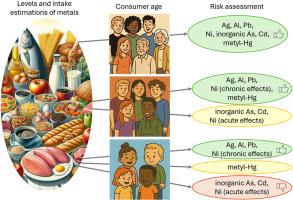Exposure to silver, aluminium, arsenic, cadmium, mercury, nickel and lead from food in Swedish children, adolescents and adults
IF 3.5
3区 医学
Q2 FOOD SCIENCE & TECHNOLOGY
引用次数: 0
Abstract
Total diet studies monitor exposure to contaminants from food. This study investigates the intakes of the harmful metals silver (Ag), aluminium (Al), arsenic (As), inorganic As, cadmium (Cd), mercury (Hg), nickel (Ni) and lead (Pb) in Swedish young children, adolescents and adults, and relate them to health-based guidance values (HBGV).
Whereas intakes of Ag and Al did not give rise to any concern for adverse health effects, most of the young children had intakes of inorganic As (≥97 %), Cd (≥71 %) and Ni (≥92 %, for acute effects) above the HBGV set by European Food Safety Authority. Some young children (2–3 %) also had higher intake of methyl-Hg (estimated by Hg from fish and eggs) than the HBGV. Whether the higher exposure to these metals during early childhood cause a greater risk of adverse health effects is unknown but our findings indicate that potential adverse health effects due to their exposure cannot be excluded. Hence, actions to reduce these intakes are desirable. Estimated intakes of Pb were below HBGV which partly disagree with blood Pb levels measured in previous studies, indicating that there are other important Pb sources than food.

瑞典儿童、青少年和成人从食物中接触银、铝、砷、镉、汞、镍和铅的情况。
总饮食研究监测食物中污染物的暴露。本研究调查了瑞典幼儿、青少年和成人中有害金属银(Ag)、铝(Al)、砷(As)、无机砷(As)、镉(Cd)、汞(Hg)、镍(Ni)和铅(Pb)的摄入量,并将其与健康指导值(HBGV)联系起来。虽然Ag和Al的摄入量没有引起任何不良健康影响的担忧,但大多数幼儿的无机As(≥97%),Cd(≥71%)和Ni(≥92%,急性影响)的摄入量高于欧洲食品安全局规定的HBGV。一些幼儿(2-3%)的甲基汞摄入量(通过鱼和蛋中的汞估计)也高于HBGV。儿童早期接触这些金属是否会导致更大的不良健康影响风险尚不清楚,但我们的研究结果表明,不能排除接触这些金属对健康的潜在不良影响。因此,减少这些摄入量的行动是可取的。估计的铅摄入量低于HBGV,这与先前研究中测量的血铅水平部分不一致,表明除了食物之外还有其他重要的铅来源。
本文章由计算机程序翻译,如有差异,请以英文原文为准。
求助全文
约1分钟内获得全文
求助全文
来源期刊

Food and Chemical Toxicology
工程技术-毒理学
CiteScore
10.90
自引率
4.70%
发文量
651
审稿时长
31 days
期刊介绍:
Food and Chemical Toxicology (FCT), an internationally renowned journal, that publishes original research articles and reviews on toxic effects, in animals and humans, of natural or synthetic chemicals occurring in the human environment with particular emphasis on food, drugs, and chemicals, including agricultural and industrial safety, and consumer product safety. Areas such as safety evaluation of novel foods and ingredients, biotechnologically-derived products, and nanomaterials are included in the scope of the journal. FCT also encourages submission of papers on inter-relationships between nutrition and toxicology and on in vitro techniques, particularly those fostering the 3 Rs.
The principal aim of the journal is to publish high impact, scholarly work and to serve as a multidisciplinary forum for research in toxicology. Papers submitted will be judged on the basis of scientific originality and contribution to the field, quality and subject matter. Studies should address at least one of the following:
-Adverse physiological/biochemical, or pathological changes induced by specific defined substances
-New techniques for assessing potential toxicity, including molecular biology
-Mechanisms underlying toxic phenomena
-Toxicological examinations of specific chemicals or consumer products, both those showing adverse effects and those demonstrating safety, that meet current standards of scientific acceptability.
Authors must clearly and briefly identify what novel toxic effect (s) or toxic mechanism (s) of the chemical are being reported and what their significance is in the abstract. Furthermore, sufficient doses should be included in order to provide information on NOAEL/LOAEL values.
 求助内容:
求助内容: 应助结果提醒方式:
应助结果提醒方式:


